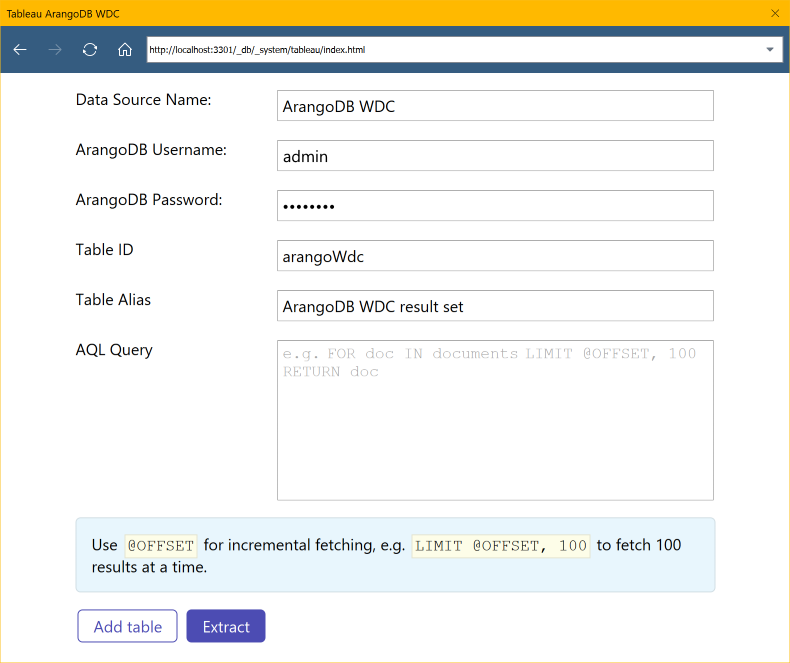This is an example Tableau connector for ArangoDB.
-
Install directly in ArangoDB
-
Extract data from AQL queries into Tableau
-
Incremental fetching with
@OFFSET -
Automatic schema inference
-
Multi-table (i.e multi-query) support
The connector can be installed as a Foxx service using the ArangoDB web interface or the Foxx CLI:
$ npm install --global foxx-cli
$ foxx install -u root -P -H http://localhost:8529 -D _system /tableau \
https://github.com/arangodb-foxx/tableau-connector/archive/master.zip
# or without installing foxx-cli:
$ npx foxx-cli install -u root -P -H http://localhost:8529 -D _system /tableau \
https://github.com/arangodb-foxx/tableau-connector/archive/master.zipTo add the connector as a data source in Tableau Desktop, use the
New Data Source command and find
Connect > To a Server > Web Data Connector or type web into the search box
and select Web Data Connector.
In the Web Data Connector browser enter the URL of the service running on your
ArangoDB instance (e.g. http://localhost:8529/_db/_system/tableau) and fill
in the required information, then press the Extract button to connect
the data source.
-
Data Source Name: Name of the data source as it will appear in Tableau.
-
ArangoDB Username and Password: Credentials that will be used to execute the queries in ArangoDB. The queries will always be executed on the same database the service was installed.
Every query result set is represented in Tableau as a table. You can add additional queries by pressing the Add table button.
-
Table ID: Identifier that will be used to uniquely identify this table in Tableau.
-
Table Alias: Human-readable description of this table in Tableau.
-
AQL Query: Query that will be executed to fetch data for this table.
The connector supports three types of query results:
-
an object mapping field names to scalar values, in this case the field names will be used as column names
-
an array of scalar values, in this case column names will be generated
-
any scalar value, in this case the value will be treated as a single column
Note: The connector will always add an additional incrementing int column
with the ID _i for technical reasons.
If you want to support incremental fetching you can use a
LIMIT statement
with an offset of @OFFSET, e.g. LIMIT @OFFSET, 100 to fetch data at
increments of 100 results at a time.
This code is licensed under the Apache License, Version 2.0.
